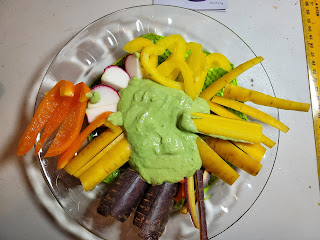After checking with some Dutch contacts online, there was disagreement if Dutch Bruine Bonen are most closely approximated with red kidney beans, or pinto beans, or some other kind of bean (somebody came up with a wild suggestion, about a bean variety I never heard of, borlotti beans, which I may also try), ideally, of course you would make it with Dutch Bruine Bonen. It should be noted that in Holland Bruine Bonen Soep is enough of a phenomenon so it has it's own website.
Anyway, my purpose no longer is to approximate my mother's recipes. My cooking has evolved over time, and it is now just a matter of improving the recipes. This time around, it will be a battle of the beans, between red kidney beans and pinto beans.
I will standardize the recipe, from the original post Dutch #WFPB Improv 001 Bruine Bonen Soep - Kidney Bean Soup.
This first go-around will be with red kidney beans.
To make the comparison meaningful, I will standardize the recipe exactly. This is the beginning of #WFPB soup science.
Ingredients
1 lb cups of red kidney beans, dry
1 strip of kombu for soaking overnight
1 tsp summer savory for cooking the beans
3 bay leaves
1 tbsp of Tianjin vegetables
3 medium size yellow onions, cut-up fine
3 shallots or other small onion
6-10 cloves of medium sized cloves of garlic, minced
1-3 toes of turmeric, minced or 1 tbsp of turmeric powder
3 sprigs of fresh thyme
1 cup water with 1 tsp of Yondu for sautéing the onions and peppers
3 Thai chili, green
2 jalapeños, cut-up fine
1 green bell pepper
1 leek, washed and sliced fine.
1 cup of eddo, shredded.
3 stalks of celery, including leaves, sliced fine
2-3 red skin potatoes, washed and diced,
1-2 carrots peeled & diced
2 tomatoes, or a 15- Oz can of diced tomatoes
12 Oz block of baked seitan (kao fu)
1 quart of vegetable broth
1 quart of water with Vegetable Better Than Bouillon
add more water as needed...
To finish: some miso (mild), or gochujan (hot), dissolved in a cup of water.
The Process
- Soak the beans overnight (minimum 6 hours ideally).
- Drain the beans and cook with water, including the kombu, and savory in the Instant Pot on high for 10 mins.
- Meanwhile, cut up the onions fine and dry roast for 5 mins at 350F (Medium High)
- Add in the minced garlic, minced shallots and chilis, pepper and turmeric and stir fry it for another five mins, adding about 1 cup of water with Yondu.
- Add in the 2 pints of veggie broth.
- Add in the cooked beans
- puree with a stick blender
- Add in the cut-up veggies, potato, tomato, thyme and seitan and simmer on low for 30 mins.
- Add more water to gain right consistency and finish the taste with miso (mild) or gochujang (hot & spicy).
Notes:
- by adding some miso or gochujang at the end, you can actually make two batches, one for folks who cannot take too much heat, and the other for the ones who love heat. Do NOT Cook the miso, just blend it in at the end, dissolved in a cup of water.
- If you cook the beans normally, it takes far longer, like 1.5 hours or so to pre-cook the beans.
- It is your option if you want it chunky or smooth. I like to purée the beans right when I add the stock (to cool them off also). Then, if you cut your veggies fine, as well as cut your seitan into small cubes, you can continue cooking and have a chunky soup or, if you want it smooth, use your trusty immersion blender once more.
- My annotations will change in terms of temperatures, but 5 minutes roasting at 350F is how it works on my equipment, but what it means is: roast it dry until the edges just start to brown. And then, you stir-fyr it by gradually adding your water with Yondu for another five minutes. If your equipment has a temperature readout, it may well be different from mine. The result is what matters.
Meanwhile, I did some research on beans... All in the interest of science, shall we say. Meanwhile, to satisfy the bean counter in me (after all, I am Dutch), I had to figure out the prices:
Next week, we'll do it again, in exactly the same way, except with Pinto beans.










